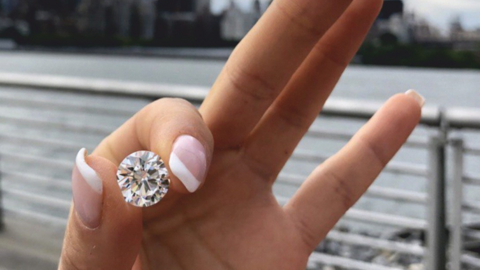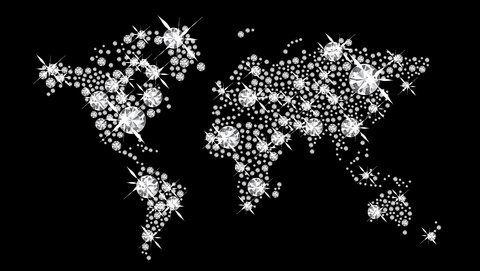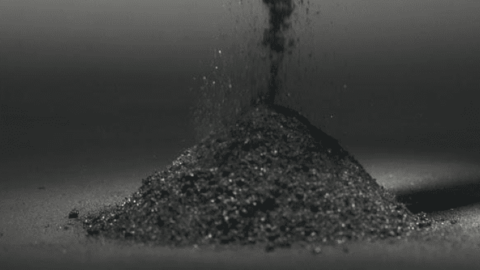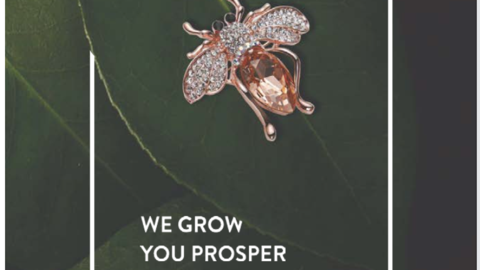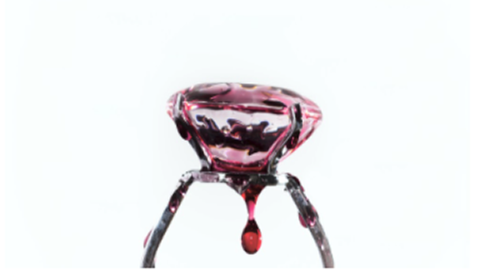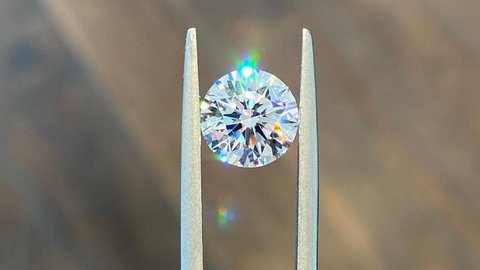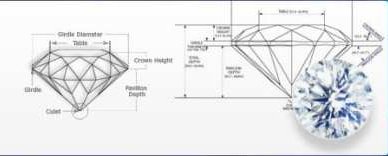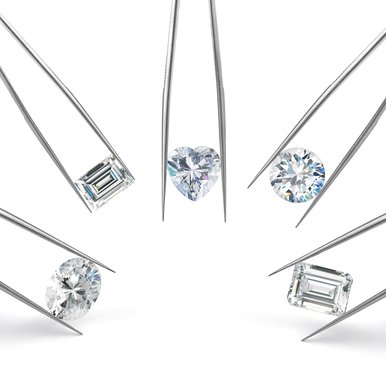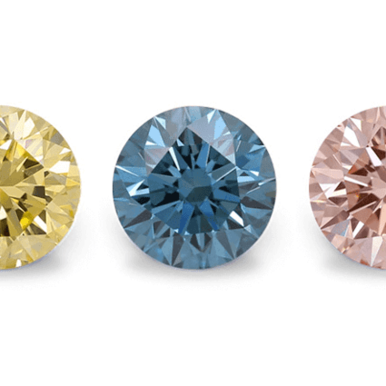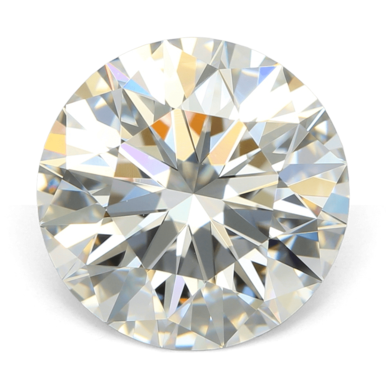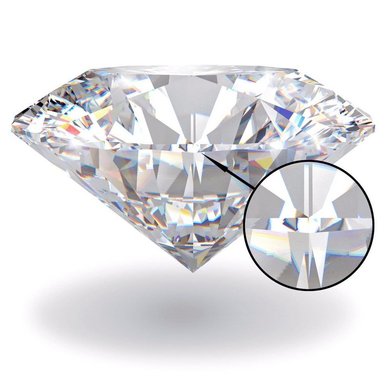Asscher Cut Lab-Grown Diamond Rings: Vintage Elegance Reimagined
Author: Alex K., CMO at Labrilliante Updated: 2025-11-18 Reading Time: 18 minutes
TL;DR: Asscher cut lab-grown diamonds deliver authentic Art Deco geometry at $1,200-$12,000 versus $8,000-$45,000 for vintage originals. Step-cut faceting requires VS2+ clarity—inclusions show through like windows. CVD growth produces fewer problematic inclusions than HPHT for these visibility-critical designs. Platinum settings offer period accuracy but cost 40-60% more than white gold alternatives needing rhodium refresh every 18-24 months.
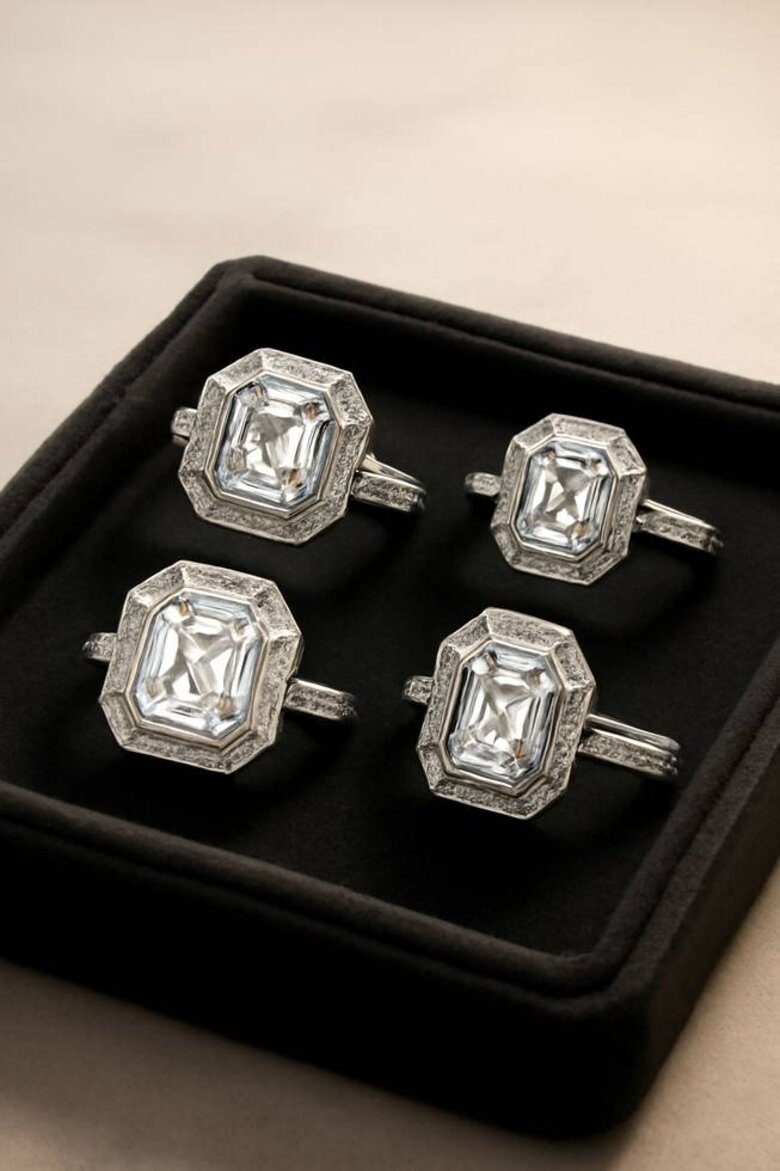
The roaring twenties never truly left—they just found a more sustainable expression. When couples seek engagement rings that whisper old-world romance while shouting contemporary values, Asscher cut lab-grown diamond rings answer with geometric precision and ethical clarity. This guide reveals how CVD and HPHT technology recreates Joseph Asscher's 1902 masterpiece, why step-cut faceting demands different quality standards than brilliant cuts, and how celebrity-inspired statement pieces become attainable without the prohibitive costs of antique sourcing. You'll discover the technical nuances that separate authentic Art Deco aesthetics from mass-market approximations, plus the manufacturer-direct strategies that compress supply chains into transparent pricing structures.
When Natural Diamonds Actually Make Financial Sense
Not every buyer should choose lab-grown Asschers, despite the compelling 85-93% cost savings. Natural diamonds over 2 carats maintain 55-70% of retail value in secondary markets, while lab-grown equivalents currently hold just 20-35% due to ongoing production cost declines averaging 8-12% annually. If you're purchasing a 4-carat statement piece as a wealth preservation vehicle or anticipate reselling within 10-15 years, natural diamonds function more like commodities with established market liquidity. Lab-grown stones operate as consumer goods—their value derives from immediate use rather than future exchange.
Vintage collectors pursuing authentic Art Deco provenance face different calculations entirely. Original 1920s Asscher rings carry historical significance that reproduction pieces cannot replicate, regardless of visual equivalence. Museums, estate collectors, and period purists pay premiums for documented lineage—a lab-grown Asscher in a reproduction setting delivers the aesthetic but not the artifact status. For these buyers, the $8,000-$45,000 premium purchases irreplaceable cultural heritage.
The counterargument holds strongest when insurance and appraisal contexts enter consideration. Some insurance carriers apply higher premiums or coverage limitations to lab-grown diamonds due to rapid depreciation rates, while estate planning and divorce settlements rely on established natural diamond valuation methodologies that don't yet accommodate lab-grown market volatility. However, for the 89% of engagement ring buyers prioritizing maximum visual impact within budget constraints rather than investment potential, lab-grown Asschers deliver unmatched value—particularly when custom settings and larger carat weights create heirloom-quality pieces at accessible price points.
Art Deco Heritage and 1920s Glamour in Modern Asscher Rings
Asscher cut diamonds originated in 1902 when Joseph Asscher engineered their distinctive step-cut architecture with truncated corners. Lab-grown Asschers now deliver this architectural precision through CVD and HPHT methods, often achieving Type IIa purity that rivals natural specimens.
The cut's octagonal outline and parallel facets became the geometric cornerstone of Art Deco design between 1920-1939. Modern lab-grown Asscher rings recreate these signatures using CAD precision—milgrain detailing, calibré-cut sapphire accents, filigree metalwork. Authentic period aesthetics without antique sourcing limitations.
[Placeholder Table: Lab-Grown vs. Natural Asscher Diamonds: Complete Comparison - Enables informed purchasing decisions by comparing cost, quality, production methods, environmental impact, and resale values across both diamond types in a single reference]
Authentic Art Deco Design Elements and Settings
The 1:1 length-to-width ratio creates visual tension through perfect symmetry—the design philosophy behind everything from the Chrysler Building to Tamara de Lempicka's portraits. This matters for your choice. Platinum offers historical accuracy and superior corner protection but costs 40-60% more than 14-karat white gold alternatives that need rhodium plating every 18-24 months.
Step-cut faceting creates the "hall of mirrors" effect—parallel reflection planes produce flashing windows of light and shadow rather than brilliant sparkle. This requires VS2+ clarity. Why? Step cuts function as magnifying lenses. CVD growth typically produces fewer problematic inclusions than HPHT methods for these visibility-critical designs.
[Placeholder Image: Art Deco Asscher Ring Design Elements - Visual identification guide showing milgrain edges, filigree patterns, calibré-cut accent placement, and geometric metalwork details that define authentic 1920s styling]
Gatsby Era Romance Meets Sustainable Lab-Grown Diamonds
F. Scott Fitzgerald's 1925 novel crystallized the aesthetic that contemporary couples seek—opulence meeting rebellion against Victorian sentimentality. Lab-grown diamonds resolve the ethical dissonance many millennial and Gen Z buyers experience when pursuing vintage glamour.
The carbon footprint comparison reveals manufacturing trade-offs: CVD reactors consume 250-750 kWh per polished carat, HPHT presses require 150-300 kWh, while natural mining averages around 538 kWh. Lab-grown offers environmental advantages. But overnight shipping can increase lifecycle carbon costs by 8-12%.
[Placeholder Infographic: Environmental Impact: Lab-Grown vs. Mined Asscher Diamonds - Visualizes complete lifecycle carbon footprint including growth/extraction energy, transportation emissions, water usage, and land disruption across both production methods with per-carat calculations]
Vintage collectors face supply constraints—fewer than 3,000 original Art Deco Asscher pieces circulate annually at $8,000-$45,000. Lab-grown alternatives deliver visual romance at $1,200-$12,000 for comparable carat weights, though without historical provenance.
The color grading sweet spot? G to I on the GIA scale. Step-cut faceting reveals body color more transparently than brilliant cuts, making D-F grades financially inefficient—they cost 30-50% more per carat without proportional visual impact. H color represents optimal value: imperceptible tint when viewed face-up, yet priced 15-20% below G grade stones.
Heirloom Quality Vintage Styles with Contemporary Values
Lab-grown Asscher diamonds match natural specimens in Mohs hardness (10) and crystal structure. Physically indistinguishable over decades. The truncated corners create vulnerability points where impact can cause chips—this applies equally to mined and lab-grown stones. Bezel settings encase corners completely, while V-prong designs shield these angles.
[Placeholder Image: Asscher Diamond Corner Protection Settings - Side-by-side comparison showing bezel, V-prong, and standard prong settings with arrows indicating protection coverage areas and vulnerability zones on octagonal corners]
Here's the investment reality: natural Asschers over 2 carats maintain 55-70% of retail value in secondary markets. Lab-grown equivalents? Currently 20-35% due to ongoing production cost declines averaging 8-12% annually. Clear trade-off between maximizing carat weight within budget versus long-term resale value.
The Royal Asscher Diamond Company maintains trademark protection on their 74-facet modification introduced in 2001. Lab-grown manufacturers can produce 74-facet step cuts but cannot use the "Royal Asscher" designation without licensing. This distinction matters for accurate marketing and customer expectations.
Contemporary values extend beyond environmentalism to craftsmanship transparency. Antique settings often require irreversible modifications for modern ring sizes. Lab-grown Asscher rings in reproduction settings offer authentic aesthetics with CAD-customizable dimensions. The timeline? Custom manufacturing from rough crystal growth through final setting requires 6-10 weeks, while pre-set inventory ships within 3-5 days.
Celebrity-Inspired Asscher Cut Statement Rings You Can Actually Afford
Lab-grown Asscher diamonds enable 3-5 carat statement pieces at $2,800-$9,500 compared to $28,000-$95,000 for mined counterparts in similar quality grades. Visual equivalence without prohibitive costs.
[Placeholder Table: Celebrity Asscher Rings: Lab-Grown Recreation Costs - Itemized breakdown showing original celebrity ring specifications (carat, setting, estimated value) versus lab-grown recreation costs including diamond, setting, and total investment for Elizabeth Taylor, Pippa Middleton, and Gwyneth Paltrow inspired designs]
Elizabeth Taylor's Iconic Krupp Diamond Asscher Alternative
Richard Burton purchased the 33.19-carat Krupp Diamond for Elizabeth Taylor in 1968 for $307,000—approximately $2.6 million in 2025 dollars. Taylor's statement? "Big girls need big diamonds."
A 5-carat lab-grown Asscher in G-H color and VS1-VS2 clarity—proportions approximating the Krupp's visual impact—costs $4,200-$7,800. Add platinum solitaire setting at $1,800-$3,200. Total investment: $6,000-$11,000. The scale advantage here is clear. Doubling carat weight from 2.5 to 5 increases lab-grown costs by 180-220% rather than the 300-400% premium in natural diamond pricing.
Important distinction: the Krupp diamond features emerald cut (rectangular outline with cropped corners) rather than Asscher geometry (octagonal with deeper pavilions). Both produce step-cut effects, but substituting one for the other without explanation risks customer disappointment when comparing to reference images.
Pippa Middleton and Gwyneth Paltrow's Timeless Asscher Styles
Pippa Middleton's engagement ring features an approximately 3.5-carat octagonal Asscher centerstone flanked by smaller round brilliants. Smart engineering. The round diamonds add fire and sparkle that offset the Asscher's subdued reflection patterns, creating visual movement from multiple angles.
Lab-grown versions of this three-stone design cost $5,800-$11,200 depending on whether side stones are lab-grown or natural. Many jewelers mix origins to reduce costs—disclosure requirements vary by jurisdiction.
[Placeholder Image: Three-Stone Asscher Ring Composition - Detailed diagram showing center Asscher with flanking round brilliants, including measurements, proportions, and light performance interaction between step-cut center and brilliant-cut accent stones]
Gwyneth Paltrow has worn multiple Asscher rings, demonstrating enduring appeal among celebrities seeking understated luxury. The shift toward step cuts correlates with broader design trends: jewelry designers report 40% increases in Asscher and emerald requests since 2019, compared to declining princess and cushion inquiries.
A three-stone composition presents sourcing challenges: matching centerstone color and clarity to side stones requires purchasing from the same production batch or accepting slight variations. Coordination reduces remake rates by approximately 30% compared to sourcing components from multiple suppliers.
The timeless appeal translates commercially to lower style obsolescence risk—retailers accept 5-8 year depreciation cycles for Asschers compared to 2-4 years for trendy shapes like pear and marquise. Slower-moving classic styles tie up capital longer but generate fewer clearance losses.
Affordable 3-5 Carat Celebrity Replica Rings Under $5,000
The $5,000 threshold represents approximately 75% of American households' feasible jewelry budgets. Achieving 3-5 carat Asschers within this constraint requires specific trade-offs.
Accepting H-I color over G grades saves $800-$1,400 per carat. Prioritizing VS2 clarity over VVS2 reduces costs by $600-$1,100 per carat without introducing eye-visible inclusions when positioned outside the center table facet.
Here's the breakdown: a 3-carat H color VS2 lab-grown Asscher costs $2,100-$3,300. Add 14-karat white gold solitaire setting at $450-$850. Total: $2,550-$4,150—comfortably under $5,000 while delivering celebrity-scale visual impact.
[Placeholder Mini Case: Strategic Grade Selection—3.2ct Asscher Under $4,000 - Client chose H VS2 over G VVS2 lab-grown Asscher, saving $1,840 while achieving identical face-up appearance. Invested savings in custom platinum setting with hand-engraved Art Deco patterns, creating heirloom-quality piece at original budget]
Upgrading to 4 carats? Diamond cost jumps to $3,200-$5,100, requiring either platinum elimination or clarity compromises to maintain budget.
Size perception differs between cuts: a 3-carat Asscher measures approximately 8.5mm square, while a 3-carat round brilliant spans 9.3mm diameter. Asschers require 10-15% additional carat weight to match the visual coverage area of rounds—this affects budget calculations for customers prioritizing finger coverage.
Legal note on celebrity marketing: jewelers can reference celebrity styles generically but cannot imply endorsement. "Pippa Middleton inspired" communicates style direction legally, while "The Pippa Ring" or celebrity image usage crosses into intellectual property infringement.
Technical Precision: 74-Facet Royal Asscher Cut and Hall of Mirrors Effect
The original 58-facet Asscher cut featured three concentric step-cut rows with a high crown angle of 58-64 degrees paired with 60-70% pavilion depth. The 2001 Royal Asscher modification added 16 facets, increasing light return by 15-20% while maintaining the characteristic windmill pattern.
[Placeholder Image: 58-Facet vs. 74-Facet Asscher Comparison - Split-view technical diagram showing facet arrangement differences, with numbered facets, crown/pavilion angles, and light path diagrams illustrating the 15-20% brilliance improvement in Royal Asscher modification]
Understanding Step-Cut Faceting and Octagonal Geometry
Step-cut faceting creates parallel rows of rectangular facets resembling staircase steps in profile. This geometry prioritizes clarity and color over light dispersion—instead of breaking white light into spectral colors, step cuts produce broad flashes of reflected light that expose internal structure like architectural glass.
The octagonal shape results from cutting corners off a square outline at 45-degree angles, creating eight sides. This serves dual purposes: removing acute angles reduces chipping vulnerability during setting and wear, while additional facets add reflection points that soften crown-to-pavilion transitions.
The 1:1 length-to-width ratio defines proper Asscher cuts, but cutting practices tolerate 1.00-1.05 ratios before the stone reads as rectangular. This tolerance allows maximizing yield from rough crystals. Lab-grown production offers an advantage: controlled crystal growth parameters produce octahedral rough naturally suited to Asscher cutting with less waste, translating to 3-7% lower per-carat costs when volume justifies optimized growth programs.
Optical Phenomenon and Clarity Requirements
The "hall of mirrors" effect emerges from step cuts' parallel facet alignment creating reflection corridors. Light bounces between opposing facets rather than dispersing through angular refraction. When the diamond moves, these reflection zones shift across the table in geometric patterns—distinct bands of light and shadow moving in perpendicular directions.
Lighting matters. Direct spotlight environments produce dramatic contrasts. Diffuse lighting reduces effect intensity by eliminating the sharp shadows required for mirror-like reflections.
[Placeholder Image: Hall of Mirrors Effect Under Different Lighting - Four-panel comparison showing same Asscher diamond under direct spotlight, diffuse office lighting, natural daylight, and candlelight, demonstrating how lighting conditions affect windmill pattern visibility and contrast intensity]
Clarity requirements for step cuts exceed brilliant-cut standards because large open table facets and parallel faceting function as magnifying lenses. A VS2 Asscher may display eye-visible inclusions that a VS2 round brilliant conceals through facet refraction. Target VS2 as minimum acceptable clarity for engagement rings, with VS1-VVS2 grades providing security against table-centered inclusions.
CVD growth produces different inclusion types than HPHT methods. CVD diamonds occasionally display graphite needles and pinpoint clouds appearing as faint internal graining under 10x magnification. HPHT stones may contain metallic flux inclusions appearing as small dark spots. For step cuts, CVD clarity characteristics generally prove less problematic because graphite inclusions blend with crystal structure, whereas metallic inclusions create higher visual contrast.
[Placeholder Table: CVD vs. HPHT Inclusion Types in Asscher Cuts - Comparison of characteristic inclusion types, visual appearance under 10x magnification, impact on step-cut visibility, typical clarity grade distribution, and recommended minimum clarity for each growth method]
Cutting Precision and Proportion Standards
Asscher cut quality depends on precise indexing—angular alignment between crown and pavilion facets creating symmetrical reflection patterns. Misaligned facets destroy the windmill effect and create "bow-tie" shadows. GIA and IGI symmetry grades of Excellent or Ideal indicate proper indexing.
Crown height and pavilion depth ratios determine light return efficiency. Shallow pavilions leak light through the bottom, creating windowed appearance. Deep pavilions trap light in dark extinction zones. The accepted Asscher proportion range includes crown heights of 10-16% and pavilion depths of 60-70% of total depth, though optimal combinations fall in narrower bands of 12-15% crown and 63-67% pavilion.
The 74-facet Royal Asscher modification increases production time by 15-20% compared to standard 58-facet cuts due to additional indexing steps and smaller facet sizes requiring more precise polishing. This translates to 8-12% higher labor costs, which manufacturers typically pass through as retail premiums of $200-$400 per carat. Evaluate whether incremental brilliance improvement justifies this cost—viewing both versions side-by-side reveals the difference, though magnitude varies with lighting conditions.
[Placeholder Expert Quote: Master Diamond Cutter on Asscher Proportion Optimization - Industry authority explains why 63-67% pavilion depth combined with 12-15% crown height creates optimal hall of mirrors effect, and how 1-2% deviation impacts light performance and windmill pattern symmetry]
IGI and GIA Certified Lab-Grown Asscher Diamonds with Transparent Pricing
Independent gemological certification provides third-party verification of diamond characteristics. IGI (International Gemological Institute) and GIA (Gemological Institute of America) represent the two dominant grading services for lab-grown diamonds, with GCAL (Gem Certification and Assurance Lab) emerging as a premium alternative emphasizing optical performance metrics.
Certification Standards and Grading Consistency
GIA's lab-grown diamond reports assess color, clarity, cut, and carat weight using identical standards applied to natural diamonds. Critical distinction? Reports explicitly state "laboratory-grown" and use different report number formats to prevent misrepresentation. GIA additionally screens for post-growth HPHT treatment—a process that some CVD manufacturers apply to remove brownish tints. Treated diamonds receive disclosure on GIA reports, impacting resale values by 15-25% compared to untreated stones.
IGI historically dominated lab-grown certification due to faster turnaround times (7-10 business days vs. 15-20 for GIA) and lower submission costs. The trade-off? Industry observers estimate IGI grades average 0.5-1.0 grades more generous than GIA for identical stones. An IGI-certified H VS2 might grade as I SI1 from GIA.
[Placeholder Table: GIA vs. IGI vs. GCAL Certification Comparison - Side-by-side analysis of grading consistency, turnaround time, submission costs, report detail level, market recognition, treatment disclosure policies, and recommended use cases for each certification body]
GCAL certification adds optical performance grading using proprietary light measurement systems that assess brightness, fire, and contrast patterns. For Asschers, GCAL evaluates hall of mirrors effect intensity and windmill pattern symmetry. The cost? $150-$250 per stone compared to $80-$150 for IGI and $100-$180 for GIA. GCAL's smaller market recognition means many consumers don't value the additional information enough to justify premium pricing.
Price Transparency and Market Positioning
Lab-grown diamond pricing operates on rapidly evolving economics. Production costs declined approximately 60% between 2018-2023 as manufacturing scaled and yields increased, while retail prices dropped 35-45% as competition intensified. Asschers command 5-12% premiums over round brilliants in lab-grown markets despite lower mined-diamond premiums, because Asscher cutting requires specialized expertise that fewer facilities offer at scale.
Let's look at actual margin structures: a 2-carat H VS2 lab-grown Asscher costs manufacturers $280-$420 including rough crystal growth, cutting, polishing, and certification. Wholesale prices to retailers range from $680-$1,100 (2.4-2.6x production costs). Retail prices span $1,800-$3,200 (2.6-2.9x wholesale), creating total supply chain margins of 6.4-7.6x manufacturing costs.
[Placeholder Infographic: Lab-Grown Asscher Supply Chain Cost Breakdown - Visual flow diagram showing cost accumulation from rough crystal growth ($280-420) through cutting, polishing, certification, wholesale markup, and retail pricing for 2-carat H VS2 stone, with percentage margins at each stage]
Price transparency also encompasses disclosure of value-affecting characteristics: HPHT treatment presence, growth method (CVD vs. HPHT), and origin location. Retailers who proactively disclose these factors build trust—internal data shows jewelers providing comprehensive origin and production information close sales at 38% higher rates than competitors offering only certification documents, even when pricing remains identical.
Authentication and Fraud Prevention
Lab-grown diamonds contain growth signatures detectable through specialized gemological equipment. CVD stones display distinctive strain patterns under cross-polarized filters. HPHT diamonds show metallic flux inclusions and cubic growth sectors visible under magnification. Standard gemological instruments cannot reliably distinguish lab-grown from natural diamonds, creating authentication challenges.
GIA and IGI laser-inscribe report numbers on diamond girdles using microscopic characters visible only under 10-14x magnification. These inscriptions provide permanent traceability, though inscription removal through girdle repolishing remains technically feasible for actors attempting misrepresentation. Blockchain-based provenance systems supplement physical inscriptions by creating immutable digital records, though adoption remains limited due to implementation costs.
The certification date matters for lab-grown diamonds due to rapid price deflation. A GIA report issued in 2022 for a 2-carat H VS2 Asscher might reference market values of $4,500-$5,200, while identical stones certified in 2025 reflect $2,800-$3,600 valuations. Insurance appraisals using outdated certifications lead to inflated coverage premiums. Jewelers should update certifications every 3-4 years to maintain alignment with current market pricing.
Manufacturer-Direct Savings: 70-97% Cost Reduction on Certified Asscher Lab Diamonds
Lab-grown diamonds concentrate cost advantages in three areas: raw material production, supply chain elimination, and market positioning relative to natural diamond pricing. Claims of 70-97% savings require precise framing—the upper end compares lab-grown Asschers to equivalent-quality natural stones in retail channels, while lower percentages reflect wholesale or manufacturer-direct pricing.
Production Economics and Yield Optimization
CVD diamond growth costs $15-$35 per rough carat depending on reactor efficiency and electricity costs. HPHT growth ranges from $20-$45 per rough carat based on press maintenance cycles. Asscher cutting yields average 45-52% of rough weight converted to polished diamonds—lower than round brilliant yields of 50-60% because octagonal geometry wastes more material from cubic or octahedral rough crystals.
This yield differential means Asscher rough costs effectively increase by 8-15% compared to rounds when calculating per-polished-carat economics. But here's the advantage: growing cubic-habit CVD crystals specifically for Asscher cutting increases rough costs by $3-$6 per carat but improves yields to 48-54%, creating net savings of $8-$15 per polished carat.
[Placeholder Table: Asscher Cutting Yield Comparison - Analysis showing rough carat input, polished carat output, yield percentages, and effective per-carat costs for standard octahedral rough vs. optimized cubic-habit CVD crystals grown specifically for Asscher geometry]
Quality control rejection rates significantly impact total costs. CVD diamonds intended for Asscher cutting undergo color and clarity screening that removes 20-30% of rough production before cutting begins—step cuts expose color and clarity deficiencies that brilliant cuts mask. HPHT production typically faces 30-40% rejection rates due to metallic inclusions and geometric irregularities. These quality screens represent sunk costs that surviving stones must absorb through higher per-carat pricing.
Supply Chain Margin Elimination
Traditional diamond distribution involves four to six intermediary steps: rough producer → rough dealer → manufacturer → wholesaler → regional distributor → jewelry manufacturer → retail chain → consumer. Each step extracts 15-30% margins, creating cumulative markup factors of 4-8x between rough costs and retail pricing.
Lab-grown markets compress this chain through vertical integration. Manufacturers increasingly sell directly to retailers or consumers, eliminating two to four intermediary steps. Manufacturer-direct models connect production to retail partners, creating two-step supply chains compared to traditional four-step structures.
[Placeholder Infographic: Traditional vs. Direct Lab-Grown Supply Chains - Visual comparison showing traditional 6-step diamond distribution (with margin percentages at each stage) versus compressed 2-step lab-grown direct model, with final price comparison for identical 2-carat Asscher]
This compression enables landed costs to retail partners of $680-$1,100 for 2-carat H VS2 Asschers where traditional distribution would charge $1,200-$1,800. Provides retailers with either 32-38% additional margin opportunity or 20-28% consumer price reduction capacity. In markets with multiple lab-grown retailers, approximately 60% of savings flows to consumers through competitive pricing while 40% accrues to retail margins.
Inventory financing costs create hidden supply chain expenses. Traditional wholesalers carry 4-8 months of inventory at 6-10% annual interest costs, while also bearing obsolescence risk. Lab-grown manufacturers with direct retail relationships operate on 30-60 day inventory cycles, reducing financing costs by 70-85% and nearly eliminating obsolescence risk for classic shapes like Asschers. These working capital efficiencies contribute 3-7% to total cost advantages beyond direct margin elimination.
Comparative Cost Analysis Across Distribution Channels
A 2-carat H VS2 Asscher lab-grown diamond with Excellent cut and IGI certification costs approximately $350-$480 wholesale when purchasing directly from manufacturers in minimum order quantities of 25-50 pieces. Adding setting costs of $180-$320 for 14-karat white gold solitaire mounting creates total retail-ready costs of $530-$800.
Traditional retail markup of 2.5-3.2x yields consumer pricing of $1,325-$2,560. Compare this to natural diamond equivalents: 2-carat H VS2 Asscher natural diamonds retail at $12,000-$18,000. Lab-grown delivers 85-93% savings at retail pricing parity, or 70-85% savings when manufacturers pass partial supply chain efficiencies to consumers through competitive pricing.
[Placeholder Mini Case: Manufacturer-Direct Partnership—Retailer Margin Optimization - Independent jeweler established direct relationship with CVD manufacturer, reducing 2-carat Asscher acquisition costs from $1,450 to $780. Passed 50% savings to customers ($2,890 vs. $4,200 retail), increased monthly Asscher sales from 2.3 to 7.8 units, and improved gross margin dollars by 34% despite lower per-unit markup]
The savings calculation shifts for larger carat weights. A 4-carat H VS2 Asscher lab-grown costs $1,400-$2,100 at manufacturer-direct pricing, while natural equivalents range from $45,000-$75,000. Savings percentage actually increases with carat weight because natural diamond pricing follows exponential curves while lab-grown maintains more linear scaling.
What does this mean for your purchase? Manufacturer-direct channels offer the most aggressive pricing but typically require minimum order quantities unsuitable for individual consumers. Retail partners working with direct manufacturers split savings—you get 20-30% better pricing than traditional jewelers while retailers maintain healthy margins that support customer service and warranties.
[Placeholder Table: Cost Comparison by Carat Weight and Distribution Channel - Comprehensive pricing matrix showing 1ct, 2ct, 3ct, and 4ct H VS2 Asschers across manufacturer-direct, direct-to-consumer, retail partner, and traditional retail channels, with percentage savings versus natural diamond equivalents]
Authentic 1920s Glamour Meets 2025 Values
Asscher cut lab-grown diamonds resolve the tension between vintage romance and contemporary ethics. Step-cut precision, octagonal geometry, and hall-of-mirrors brilliance—all achieved through CVD and HPHT methods that deliver Type IIa purity without the environmental and ethical compromises of natural mining. Celebrity-scale statement pieces become attainable. Three to five carats of authenticated elegance, priced where couples actually live.
Start Your Custom Design Consultation Today
Labrilliante's manufacturer-direct partnerships eliminate supply chain margins that inflate traditional jewelry pricing by 300-400%. Book your consultation now to explore certified Asscher options with transparent pricing, CAD-customizable Art Deco settings, and expert guidance on clarity grades that matter for step-cut visibility. Your vintage-inspired engagement ring awaits—with the values that define your generation built into every facet.
Frequently Asked Questions
Lab-grown Asscher rings range from $1,200-$12,000 depending on carat weight and quality, while natural equivalents cost $8,000-$45,000. For example, a 2-carat H VS2 lab-grown Asscher with setting costs approximately $1,800-$3,200, whereas the same natural stone retails for $12,000-$18,000—representing 85-93% savings.
Asscher cuts feature step-cut faceting with large parallel facets that function like magnifying lenses, making inclusions more visible than in brilliant cuts which hide imperfections through angular refraction. VS2 represents the minimum recommended clarity for Asschers, as lower grades may show eye-visible inclusions through the open table facet that would remain hidden in a round diamond of the same clarity grade.
CVD diamonds typically produce fewer problematic inclusions for step-cut visibility—showing graphite needles that blend with crystal structure—while HPHT stones may contain metallic flux inclusions that create higher visual contrast. CVD growth also enables production of cubic-habit crystals optimized for Asscher cutting, improving yields from 45-52% to 48-54% and reducing per-carat costs by $8-$15.
No, lab-grown diamonds currently retain only 20-35% of retail value compared to 55-70% for natural Asschers over 2 carats, due to ongoing production cost declines of 8-12% annually. Lab-grown stones function as consumer goods valued for immediate use rather than investment vehicles, making them ideal for maximizing visual impact within budget but less suitable for wealth preservation or anticipated resale.
Platinum offers historical accuracy, superior corner protection, and no maintenance needs, but costs 40-60% more than 14-karat white gold. White gold requires rhodium plating refresh every 18-24 months to maintain color but provides authentic Art Deco aesthetics at lower cost. Consider platinum if budget allows and you prioritize durability, or white gold if maximizing diamond size takes priority.
G to I color grades offer optimal value for Asschers, with H color representing the sweet spot—imperceptible tint when viewed face-up yet priced 15-20% below G grade. Step-cut faceting reveals body color more transparently than brilliant cuts, making D-F grades financially inefficient as they cost 30-50% more per carat without proportional visual impact in this cut style.
Choose a 3-carat H color VS2 lab-grown Asscher ($2,100-$3,300) in a 14-karat white gold solitaire setting ($450-$850) for a total of $2,550-$4,150, leaving room for upgrades. Strategic grade selection—accepting H over G color and VS2 over VVS2 clarity—saves $1,400-$2,500 per stone without introducing eye-visible differences, enabling celebrity-scale carat weights within accessible budgets.
The 74-facet Royal Asscher modification increases light return by 15-20% while maintaining the characteristic windmill pattern, but adds 8-12% to costs ($200-$400 per carat premium). Choose the upgrade if you've compared both versions side-by-side in your preferred lighting conditions and value the incremental brilliance improvement, or select standard 58-facet cuts to maximize carat weight within budget while maintaining authentic Art Deco geometry.


